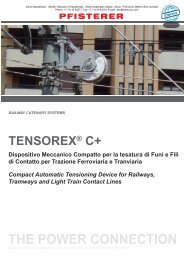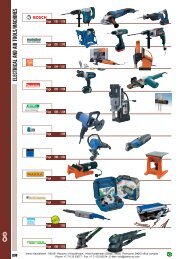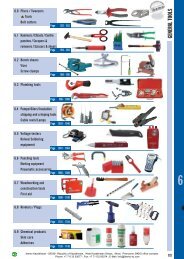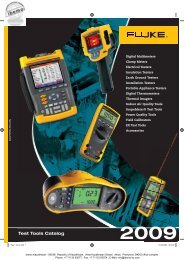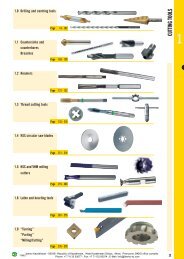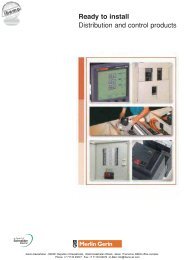General Catalogue 2007 - Ibemo Kazakhstan Ltd
General Catalogue 2007 - Ibemo Kazakhstan Ltd
General Catalogue 2007 - Ibemo Kazakhstan Ltd
You also want an ePaper? Increase the reach of your titles
YUMPU automatically turns print PDFs into web optimized ePapers that Google loves.
Basic Principles<br />
The proper selection of the correct circuit protective device requires<br />
an understanding of the potential hazards against which protection<br />
for safety is required. The Wiring Regulations identify several<br />
hazards:<br />
• Electric shock<br />
• Thermal effects<br />
• Overcurrent<br />
• Undervoltage<br />
• Isolation<br />
Electric shock - is divided into two parts:<br />
• Direct contact: contact with parts which result in an electric shock<br />
in normal service<br />
• Indirect contact: contact with exposed conductive parts which<br />
result in an electric shock in case of a fault.<br />
To protect against direct contact the Wiring Regulations<br />
suggest the following basic measures should be taken:<br />
(1) by insulation of live parts<br />
(2) by enclosures or barriers<br />
(3) by obstacles<br />
(4) by placing out of reach<br />
To protect against indirect contact the Wiring Regulations suggest the<br />
following basic measures should be taken:<br />
(1) Earthed equipotential bonding and automatic disconnection of<br />
supply<br />
(2) Use of class II equipment or equivalent insulation<br />
(3) Non-conducting location<br />
(4) Earth-free local equipotential bonding<br />
(5) Electrical separation<br />
Of these five measures, the first is by far the most commonly used -<br />
(1) Earthed equipotential bonding and automatic disconnection of<br />
supply:<br />
In each installation circuit protective conductors connect all exposed<br />
conductive parts of the installation to the main earthing terminal.<br />
Main equipotential bonding conductors are used to connect<br />
extraneous conductive parts of other incoming services and<br />
structural metalwork to the main earthing terminal. These extraneous<br />
conductive parts include the following:<br />
• Main water pipes<br />
• Gas installation pipes<br />
• Other service pipes and ducting<br />
• Risers of central heating and air conditioning systems<br />
• Exposed metal parts of the building structure<br />
This bonding creates a zone within which any voltages appearing<br />
between exposed conductive parts and extraneous conductive parts,<br />
are minimised; the earth fault loop impedance must have a value<br />
low enough to allow sufficient current to flow for the circuit protective<br />
device to operate rapidly to disconnect the supply; disconnection<br />
must be sufficiently fast so that voltages appearing on the bonded<br />
metalwork cannot persist long enough to cause danger; depending<br />
on the operating characteristics of the protective device and the earth<br />
impedance, such disconnection may be achieved either by<br />
overcurrent devices, Fuses, Miniature Circuit Breakers, (i.e. MCBs) or<br />
by Residual Current Devices, (i.e. RCCBs).<br />
Thermal Effect - refers to heat generated by the electrical<br />
equipment in normal use and under fault conditions. The proper<br />
selection of equipment complying with the latest product standards is<br />
essential in providing protection against thermal effects.<br />
Overcurrent - is defined as a current exceeding the rated value of the<br />
circuit components. It may be caused by the overloading of a healthy<br />
circuit or it may take the form of a short-circuit current, defined as an<br />
“overcurrent resulting from a fault of negligible<br />
impedance between live conductors having a difference in potential<br />
under normal operating conditions”. Overcurrent protection may be<br />
provided by using fuses or circuit breakers singly or in combination.<br />
3.32<br />
Hager <strong>Catalogue</strong> <strong>2007</strong> • Technical<br />
Circuit Protection Principle<br />
Undervoltage - refers to the dangers that could be caused by the<br />
reduction or loss in voltage and the subsequent restoration, such as<br />
the unexpected re-starting of motors or the automatic closing of<br />
protective devices. The proper selection of control and protective<br />
devices must take the protection against undervoltage into<br />
consideration.<br />
Isolation - every circuit shall be provided with means of isolation<br />
(except in certain cases) to prevent or remove hazards associated<br />
with the installation, equipment and machines. The new standards for<br />
circuit breakers and switch-fuses now take this into account.<br />
Protection against shock by indirect contact<br />
Indirect contact - is the contact of persons or livestock with exposed<br />
conductive parts made live by a fault and which may result in electric<br />
shock. An example would be where the insulation of an electric<br />
heater has broken down resulting in a live conductor internally<br />
touching the casing. This could result in the heater casing being<br />
raised to a hazardous voltage level, causing electric shock to a<br />
person touching it.<br />
Two important measures must be taken to prevent this hazard:<br />
• The impedance of circuit conductors is kept to a minimum. The<br />
earth fault loop impedance (Zs) is used as a measure of the<br />
circuit impedance under fault conditions.<br />
• The overcurrent device protecting the circuit is selected to rapidly<br />
disconnect an earth fault.<br />
The effect of these two measures is inter-related.<br />
1. By ensuring that the circuit protective conductor is of a low<br />
impedance, the voltage to which the live casing is raised, under<br />
fault conditions, is kept to a minimum.<br />
2. The low impedance path provided by the circuit conductors and<br />
the circuit protective conductor will result in a high level of<br />
current in the event of an earth fault. This high fault current ensures<br />
that the overcurrent protective device will disconnect the fault in a<br />
short time, reducing the interval during which the casing of the<br />
faulty equipment is live.<br />
Z e<br />
Fig 2<br />
transformer<br />
winding<br />
L1<br />
N<br />
E<br />
consumer's<br />
terminals<br />
R 1<br />
load<br />
terminals<br />
R 2<br />
Components of earth fault loop impedance (Z s ) in a system.<br />
(Earth fault at load between conductor and casing).<br />
Z s = Z e + (R 1 +R 2 )<br />
load<br />
Earth fault loop impedance (Z s )<br />
To ensure the impedance of conductors in a circuit is sufficiently low<br />
the system designer has to establish the value of the earth fault loop<br />
impedance.<br />
Z s is a measure of the earth fault current loop, comprising the<br />
phase conductor and the protective conductor. It comprises the<br />
complete loop including the winding of the transformer from<br />
which the circuit is supplied as defined by the following:<br />
Z e is the part of the earth fault loop impedance external to the<br />
installation, its value can be measured or a nominal value can<br />
be obtained from the supply authority.<br />
ibemo <strong>Kazakhstan</strong> - 090301 Republic of <strong>Kazakhstan</strong>, West <strong>Kazakhstan</strong> Oblast, Aksai, Pramzone, BKKS office complex<br />
Phone: +7 71133 93077 ; Fax: +7 71133 93074 ; E-Mail: info@ibemo-kz.com



